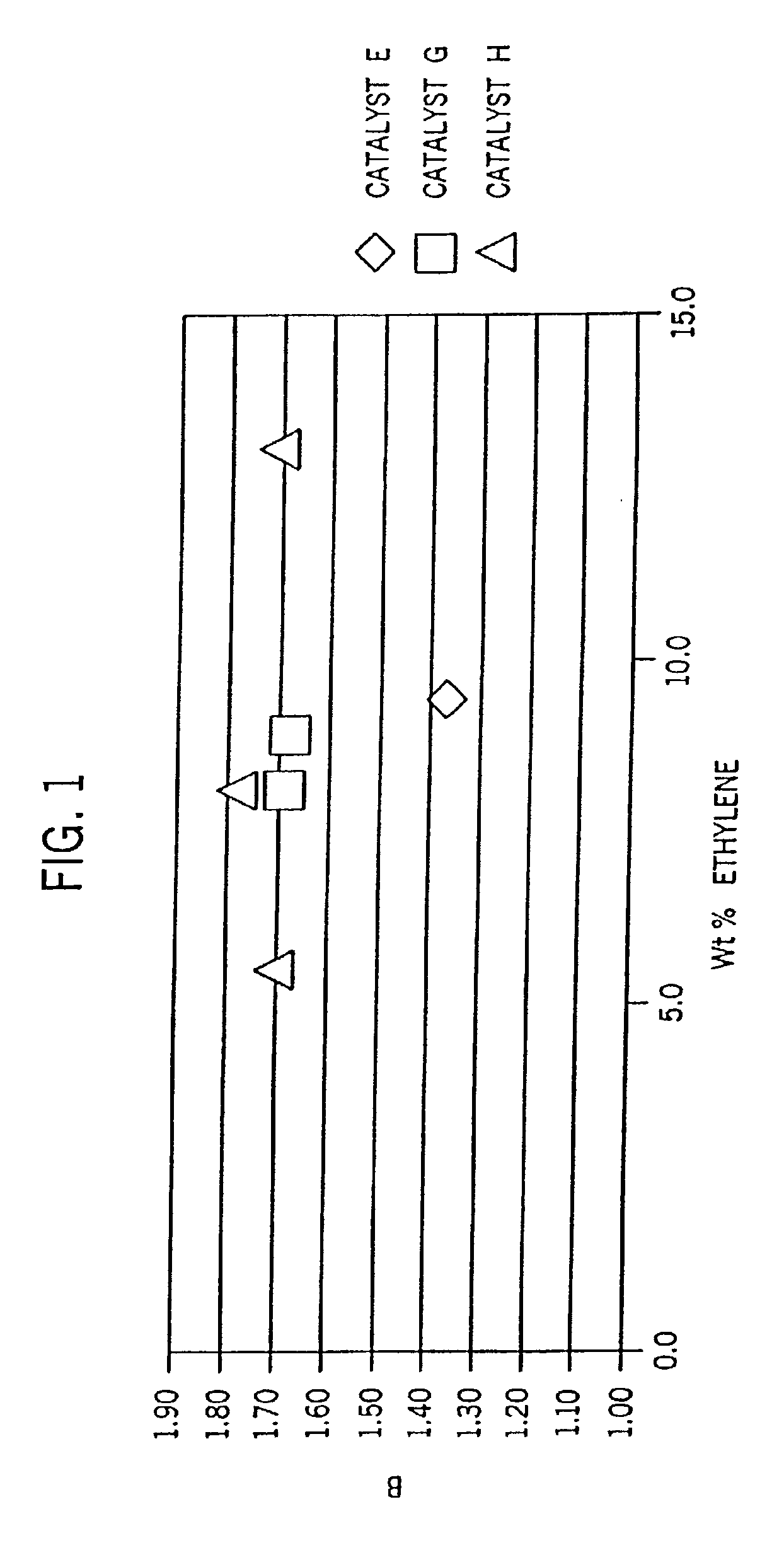Isotactic propylene copolymer fibers, their preparation and use
a technology of isotactic propylene and copolymer fibers, applied in the field of fibers, can solve the problems of relatively difficult economic use of propylene homo- or copolymer with metallocene catalyst, especially in the solution process
- Summary
- Abstract
- Description
- Claims
- Application Information
AI Technical Summary
Benefits of technology
Problems solved by technology
Method used
Image
Examples
specific embodiments
[0290]Tetrahydrofuran (THF), diethyl ether, toluene, hexane, and ISOPAR E (obtainable from Exxon Chemicals) are used following purging with pure, dry nitrogen and passage through double columns charged with activated alumina and alumina supported mixed metal oxide catalyst (Q-5 catalyst, available from Engelhard Corp). All syntheses and handling of catalyst components are performed using rigorously dried and deoxygenated solvents under inert atmospheres of nitrogen or argon, using either glove box, high vacuum, or Schlenk techniques, unless otherwise noted. MMAO-3A, PMAO, and PMAO-IP can be purchased from Akzo-Nobel Corporation.
Synthesis of (C5Me4SiMe2NtBu)Ti(η4-1,3-pentadiene) (Catalyst A, FIG. 12A)
[0291]Catalyst A can be synthesized according to Example 17 of U.S. Pat. No. 5,556,928.
Synthesis of dimethylsilyl(2-methyl-s-indacenyl)(t-butylamido)titanium 1,3-pentadiene (Catalyst B, FIG. 12B)
[0292]Catalyst B can be synthesized according to Example 23 of U.S. Pat. No. 5,965,756.
Synthe...
example 1
Propylene / Ethylene Polymerization
Using Metallocene Catalyst E (Comparative)
[0327]The general procedure for the 1 gallon continuous solution polymerization outlined above was employed. A catalyst solution containing 2.6 ppm Zr from Catalyst E was prepared and added to a 4 L catalyst storage tank. This solution was combined in a continuous stream with a continuous stream of a solution containing Armeenium tetrakis(pentafluorophenyl)borate in toluene and a continuous stream of a solution of PMAO-IP in toluene to give a ratio of total Ti:B:Al of 1:1.2:30. The activated catalyst solution was fed continuously into the reactor at a rate sufficient to maintain the reactor temperature at approximately 80 degrees C. and a polymer production rate of approximately 3 pounds an hour. The polymer solution was continuously removed from the reactor exit and was contacted with a solution containing 100 ppm of water for each part of the polymer solution, and polymer stabilizers (i.e., 1000 ppm Irgapho...
examples 2-6
[0328]Examples 2-6 were conducted similar to Example 1 except as otherwise noted in Tables 2-6-1 and 2-6-2 below. Catalyst E is listed for comparative purposes. FIG. 8 is the 13C NMR sprectrum of the propylene / ethylene copolymer product of Example 2. FIGS. 2A and 2B show a comparison of the DSC heating traces of the propylene / ethylene copolymers of Comparative Example 1 and Example 2.
[0329]
TABLE 2-6-1Polymerization ConditionsPOLYReactorSOLVC2C3H2LBS / HRTEMPFLOWFLOWFLOWFLOWproductionExampleDEGCLB / HRLB / HRLB / HRSCCMrate1 (compara-80.536.00.5011.0003.13tive)280.533.00.206.0020.83.47380.126.00.106.0014.13.09479.926.00.206.0020.13.25580.026.00.306.0026.13.16680.326.00.406.0032.13.32
[0330]
TABLE 2-6-2Monomer conversion and activitycatalystefficiencyC3 / C2propyleneethyleneconcentrationg metalExampleCatalystratioconversionconversionppm (metal)per g polymer1 (comparative)E22.0025.7%64.8% 2.66,145,944 2G30.1753.1%99.1%25.6235,8233H61.0748.7%98.4%55.0225,6664H30.3449.7%99.0%55.0259,5455H20.1746.8%...
PUM
| Property | Measurement | Unit |
|---|---|---|
| Fraction | aaaaa | aaaaa |
| Temperature | aaaaa | aaaaa |
| Temperature | aaaaa | aaaaa |
Abstract
Description
Claims
Application Information
 Login to View More
Login to View More - R&D
- Intellectual Property
- Life Sciences
- Materials
- Tech Scout
- Unparalleled Data Quality
- Higher Quality Content
- 60% Fewer Hallucinations
Browse by: Latest US Patents, China's latest patents, Technical Efficacy Thesaurus, Application Domain, Technology Topic, Popular Technical Reports.
© 2025 PatSnap. All rights reserved.Legal|Privacy policy|Modern Slavery Act Transparency Statement|Sitemap|About US| Contact US: help@patsnap.com



